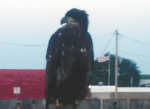Young ailing eagle is rescued at Fort Scott business

A unique visitor of the avian variety landed in Fort Scott Tuesday night.
A small gathering of people grew into a slightly larger one in the side parking lot of Family Video to observe what has been confirmed as a juvenile bald eagle that had perched atop a fence surrounding the trash dumpster in the business' parking lot.
This reporter was among a group of people that stayed on the scene until the bird was rescued to see how the situation played out.
With cell phones out, several people attempted to approach the bird for photos and to observe its behavior, which seemed odd as it did not react to onlookers and showed no signs of taking flight. Except for the occasional sway in the wind, moving of its head or ruffling of feathers, the bird never moved from its perch and did not take flight while on many occasions surrounded by onlookers of various ages.
Justin Harbit with the Kansas Department of Wildlife, Parks and Tourism, who later captured the bird, said the bird has become more common in the area. He said the bald eagle had been on the endangered species list but is no longer considered endangered.
"They've been expanding their breeding range for quite awhile," Harbit said. "They're more common now than they ever were."
After being caged for transport, the eagle was taken to Operation Wildlife, a wildlife rehabilitation facility near Lawrence, where tests were run to determine what was wrong with the eagle.
"The bird had a low lead poisoning toxicity," Harbit said Wednesday. "It was very emaciated and there were some parasite issues. When I left the clinic last night, there was at a minimum a minor case of lead poisoning, but that was not the main reason. What probably happened is it ingested some lead some time ago and when they do that, that toxin is stored ... it triggered a loss in weight. It lost one-third of its body weight. This was not a recent event.
"Quick tests they ran that night showed elevated levels of lead. There were some additional things wrong with it," Harbit said, adding this was the only information he had on the bird's condition. "It was fine when I left. If they figure out what's wrong with it and treat it, I would expect a full recovery."
Harbit said once the bird recovers, it would be released but he did not know a location.
Fort Scott City Commissioner Jim Adams was among the spectators Tuesday night. Adams encouraged some onlookers to be cautious and move away so as not to provoke or scare the bird. Photos were discouraged by city officials present as dark came so flashes would not spook the bird.
"I didn't want to scare the bird and have it jump off and injure itself," Adams said. "Plus, an eagle can tear you to pieces. If a bird decided it was scared, those rear talons move at incredible speeds."
Fort Scott Police Chief Travis Shelton, who was not on duty at the time, stopped by to observe the situation after catching a glimpse of the eagle. Shelton said he has seen adult eagles near the city's wastewater plant, "but I've never seen one in town. I haven't seen a juvenile like that sick or injured. It was an experience."
A few on-duty Fort Scott police officers were on hand to observe and for precautionary reasons, Shelton said.
"They were on standby while Justin Harbit was on the way," he said.
Harbit said state regulations in place prohibit citizens from capturing wildlife and "any young animal" and keeping them as pets. He said regulations "get stricter when moving into federal species," which the eagle falls under.
"People take them home and it's a death sentence to these little animals," he said. "If they find a baby animal, they should leave it where they found it. The mother will take care of it. They're not getting saved by taking in young animals."
Eagles, with their talons and beaks, can potentially be dangerous, Harbit said.
"They have fairly good sized talons," he said. "We ask the general public not to intervene with wildlife. They can call the game agency responsible and we'll take it from there. It's never a good idea to take it in when it's sick or injured to rehabilitate."
Adams said he appreciates state and federal rules "against capturing a raptor or being in possession of them or parts of them."
"It's good to know how protected those birds are," he said. "Especially the bald eagle. That's our number one bird."
